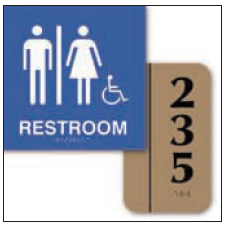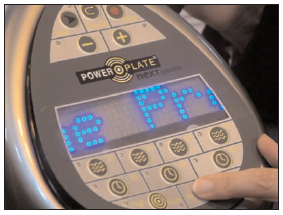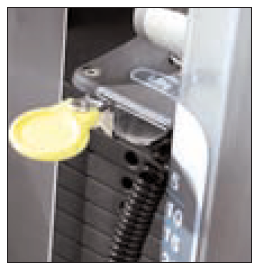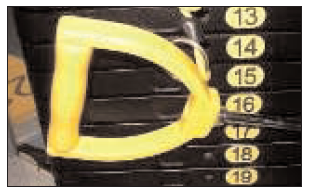Using a Fitness Center Does Not Have to be an Exercise in Frustration: Tips for People with Mobility and Visual Disabilities
3. Tips for People with Visual Disabilities
If you join a fitness center, you want to have the same access to all areas, programs and services as other members of the facility. Accessibility issues and barriers are different for each individual, but some barriers are common for people with visual disabilities. Anita Aaron describes her experience this way:
To fully participate in a fitness facility, I either need to hire (and then train) a personal trainer or memorize by repeated trips with a sighted guide the equipment that I am able to use without assistance and where it is located. Of course, that only works until the personal trainer and equipment is moved around. I know of no gym or fitness center that has incorporated cardio equipment with audio or Braille information into its fleet of equipment choices. The more electronic and digital exercise equipment becomes, the more impossible it is for blind people to use. It is almost impossible for someone with significant vision loss to participate at a gym or fitness center without a sighted guide. (Some of the issues are) Navigating the crowded landscape (crowded with people and equipment), locating the equipment you want to use, being able to set up the equipment for yourself, i.e., set time and speed on treadmills or exercise bikes or set weight machines for position and amount of weight, or find free weights, dressing rooms, etc. are all partially or totally inaccessible. 6
6 Anita Aaron, Executive Director of the Rose Resnick Lighthouse in San Francisco, personal e-mail 2005
3.1 Plan Ahead
When looking for a fitness center or preparing to visit a center for the first time, it is helpful to ask questions ahead of time so you know what to expect. For example, you may want to know:
-
Is the facility on a public transit route (e.g., bus, subway, train)?
-
Can you tell me how to find the facility (e.g., it’s on the same side of the street as the bus stop, the first entrance at the end of the block after you get off the bus)?
-
Who should I ask for when I get there (e.g., membership manager or front desk staff)?
During your first visit, you might want to know more specific details.
-
Ask for a tour of the facility. Before you start, you may want to ask the staff first to describe the overall facility (e.g., the facility has two floors; the cardio equipment is on the first floor and the weight equipment is on the second floor). Once you understand how the center is laid out, they should take you through it.
-
Ask about the qualifications and training of the staff on adapting activities and working with people with disabilities to develop a fitness program. 7
7 Choosing a Fitness Center. (2006). Retrieved September 21, 2007 from National Center for Physical Activity and Disability Web site: http://www.ncpad.org/exercise/fact_sheet.php?sheet=359&view=all#5
3.2 Physical Accessibility Barriers and Solutions
| Barriers | Solutions | |
| Simple/Low cost | Involved / High cost | |
| Protruding Objects mounted on the wall (e.g., fire extinguisher) may endanger your head | Place a cane-detectable object (such as a potted plant) under the object to redirect walkers | Remove the object from the wall |
| Signs are inaccessible (not tactile) | Create temporary signs (e.g., using a Braille writer) for permanent spaces such as the restroom, etc. | Install permanent, accessible (tactile) signs |
| Locks on the lockers are not accessible | Locks on the lockers are not accessible | Install accessible locks on all lockers |
Permanent accessible tactile signs
3.3 Equipment Barriers and Solutions
| Barriers | Solutions | |
| Simple/Low cost | Involved / High cost | |
| Display and/or controls on the equipment is not accessible | Put tactile labels on or near the controls on the machine. (You can create your own tactile labels by using a piece of duct tape or Braille labels made from contact paper and a Braille writer.) | Purchase equipment with tactile displays and/or audible (sound) output |
| Unable to locate pin and make other adjustments to equipment | Place high-contrast and tactile labels on the adjustment parts (e.g., colored, textured tape on the weight adjustment pin) | Purchase equipment with colors that contrast (e.g., a bright color against a dark background on the adjustment features, such as the weight amount or seat height and labels that are raised |
| Some parts of the equipment stick out and endanger users | Place high contrast tape or add padding to parts that stick out | Purchase equipment without parts that stick out (or that have padding) |
| Directions for how to use the equipment is not accessible (e.g., it may be hung on the wall or be in small print) | Type the instructions in large print (at least 18 point font) and attach them to the equipment with a cord or chain so that a user can hold them in thier hand to read | Provide instructions at a level that can be read easily by wheelchair users, and in audio format. (Audio files could be available at the center or be posted on a website to be downloaded ahead of time |
An input console has tactile indicators to help users program exercise bicycles, steppers, treadmills, etc. The display uses large print.
A weight adjustment pin that is large, flat, round, and yellow
A weight pin grip is large and open. The weight number labels are large, raised, and yellow (high contrast)
3.4 Staff-Related Barriers and Solutions
| Barriers | Solutions | |
|---|---|---|
| Simple/Low cost | Involved / High cost | |
| Staff is hard to find when you need help | Work out a signal with one or two staff members who will be in the area where you might need help | Staff should wear clearly visible uniforms that are different from the clothes that members usually wear and that contrast with the surroundings (e. not black) |
| Staff and other members leave exercise equipment and other “stuff” on the floor in the gym area that could trip you | Post signs to remind people not to leave exercise equipment or other stuff on the floor | Assign staff to keep the floor areas clear of tripping hazards |
| Staff is unaware of the needs of people with visual disabilities | Discuss your specific needs with the staff members that you work with | Facility should train all staff members on disability issues |
3.5 Other Tips for Increasing Access
Other issues can make using a fitness center difficult, such as bringing a service animal with you, using lockers, attending group classes, and using swimming pools. The following tips should make these experiences a little easier.
-
If you use a service animal you should talk with staff to avoid any surprises or misconceptions.
-
Think about where you will safely place your animal when you are using the equipment or swimming.
-
Decide what you will do if your animal has difficulty with loud noises or music.
-
-
Find out ahead of time how the lockers are used and assigned.
-
If lockers are assigned at each visit, work with the staff to make sure you have a locker in a location that is easy to find. A corner locker may be the easiest to find.
-
If lockers are given on a first come-first served basis, ask to be assigned a permanent locker to be sure one will be available you can use when you visit.
-
-
If you want to take part in a group class, get familiar with the room and any equipment before the class starts.
-
Talk to the instructors before the class to let them know you will be there, so you will both know what to expect.
-
Tell instructors the best way to communicate with you and ask them to describe what they are doing.
-
-
If you want to use the swimming pool, first get familiar with the pool area by walking the length and width of the pool.
-
Learn where the lifeguard stand is and where other obstacles on the pool deck are, such as pool toys (water noodles, kick boards, etc.)
-
You may want to swim in the lane closest to a wall.
-





User Comments/Questions
Add Comment/Question